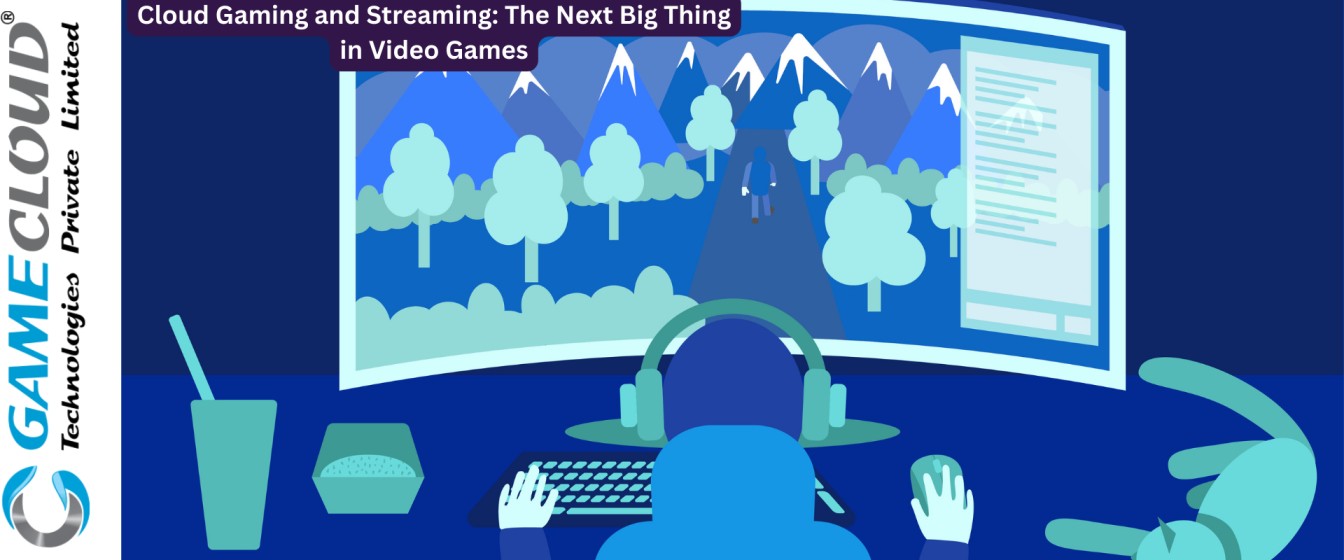
Cloud gaming and streaming have revolutionised the video game industry, making games more accessible, portable, and affordable for a wider audience. This innovative technology allows gamers to play their favourite titles on any device with an internet connection, without the need for expensive gaming hardware. The cloud gaming market is dominated by key players such as Google, Microsoft, and Amazon, who offer subscription-based services that grant users access to vast libraries of games.
Cloud gaming operates by running games on remote servers hosted by cloud gaming providers. These servers handle the heavy lifting, including rendering graphics and processing inputs. The user’s device, such as a smartphone, tablet, or laptop, acts as a controller, sending inputs to the server over the internet. The server then streams the game’s graphics and audio back to the user’s device in real-time, giving the impression that the game is running locally.
While cloud gaming is still in its early stages, there is a lot of potential for growth and innovation in the future. Advancements in technology, such as 5G networks and edge computing, could help overcome some of the challenges associated with cloud gaming, such as latency and input lag.
Evolution of Cloud Gaming
The evolution of cloud gaming has been a significant journey from its inception in the mid-2000s to its current state as a game-changing technology. Initially introduced by startups like G-cluster in 2000, cloud gaming began to gain traction as internet speeds and streaming technologies improved.
Over time, cloud gaming has evolved to address various challenges and limitations. Initially, games were rendered entirely in the cloud, requiring significant computation. However, the concept of Cloud-Native Games emerged, where games are partially played in the cloud but rendering is performed on the client side. This approach, exemplified by companies like Roblox, allows for more scalable multiplayer experiences and social gaming platforms where users can create and play games.
The future of cloud gaming holds immense potential for growth and innovation. Advancements in technology, such as 5G networks and edge computing, are expected to enhance the cloud gaming experience by addressing challenges like latency and input lag. Cloud gaming is poised to become the go-to platform for gamers, especially with the increasing popularity of mobile gaming and the continuous evolution of cloud-native gaming solutions.
How Cloud Gaming Works
Cloud gaming is a method of playing video games on remote servers and streaming them to users’ devices over the internet. The process involves running the game on a server, which then sends the video and audio output back to the player’s device in real-time. This allows users to play games without needing to install them on their local devices or purchase expensive gaming hardware.

Here’s a detailed explanation of how cloud gaming works:
- Input commands: When a player initiates a game, their input commands are sent to the remote server.
- Game processing: The server processes the game, using powerful hardware and software to render the game’s graphics and audio.
- Streaming: The video and audio output of the game are then streamed back to the player’s device in real-time.
- Display: The player’s device displays the game’s graphics and audio, providing a seamless gaming experience.
The user’s device acts as a controller, sending input commands to the remote server. This allows for cross-platform syncing and support for various input devices, such as controllers, keyboards, and mice. The user’s device also needs to handle the internet bandwidth required for streaming the game.
Cloud gaming has several advantages over traditional gaming methods:
- Accessibility: Players can access high-quality games on various devices, including smartphones, tablets, and low-end PCs, without the need for expensive consoles or gaming rigs.
- Cost-effectiveness: Players pay a subscription fee to access a library of games, eliminating the need to purchase individual titles and gaming equipment.
- Scalability: Cloud gaming platforms can quickly and efficiently allocate additional server resources to handle increased demand, ensuring a consistent and smooth gaming experience for players.
However, cloud gaming also has some challenges, such as the need for a stable internet connection and the potential for high latency and dropped frames. Not all games may translate well when played over cloud gaming technology, as some games require high response times to function properly.
Benefits of Cloud Gaming for Gamers
The benefits of cloud gaming for gamers are significant and have the potential to transform the gaming experience. Here are the key benefits outlined from the provided sources:
- Easy Access to a Variety of Games: Cloud gaming provides gamers with easy access to a wide range of video games right at their fingertips. This accessibility allows players to enjoy a dynamic gaming experience with a vast selection of games available.
- Immersive Gaming Experience: Cloud gaming offers an immersive gaming experience by leveraging powerful GPUs in data centres to ensure the best in-game graphics and intelligence. This technology allows gamers to enjoy graphically intensive games without interruptions, even on devices that may not have the latest hardware.
- Security: Cloud gaming platforms offer enhanced security by storing information in virtual storage spaces, making them safer than traditional applications. Game publishers have the legal right to stream games on their platforms, ensuring that games remain unaltered and piracy is prevented. This security feature helps deter piracy and ensures user data is stored securely on servers, eliminating privacy concerns.
- Reduced Cost: One of the major benefits of cloud gaming is the reduced cost for gamers. Players no longer need to constantly upgrade their hardware to keep up with the latest gaming trends. By purchasing hardware once or using their mobile devices, they can enjoy gaming for life. The subscription fee includes a library of games that can be seamlessly accessed and enjoyed, offering numerous options for free cloud gaming.
- Compatibility Across Devices: Cloud gaming enables compatibility across various devices, allowing even low-end devices to support high-end video games. This is made possible by cloud gaming services that allow games to be played across multiple platforms, including Android, iOS, PCs, and tablets. Cloud gaming technology addresses traditional gaming limitations such as memory storage, graphics capacity, and processing power, providing gamers with a seamless and brilliant gaming experience.

The Metaverse and Cloud Gaming
The metaverse is a virtual realm that has the potential to shape the future of gaming by creating a virtual environment where users can interact and engage in various experiences beyond traditional gaming. The metaverse is considered the next iteration of the internet and has the potential to generate trillions of dollars by revolutionising gaming and advertising with immersive 3D experiences, creating new revenue streams through NFTs and play-to-earn models, and enabling greater interoperability between games.
The metaverse is powered by advanced technologies such as blockchain, cryptocurrency, AR & VR, artificial intelligence, 3D reconstruction, IoT, edge computing, and 5G. These technologies allow for the creation of a seamless, interconnected virtual world where users can move between different virtual environments, creating a more personalised gaming experience that reflects their interests and preferences.
One of the key benefits of the metaverse is the potential for social interaction and community building. By allowing users to interact in a shared virtual world, the metaverse can create a sense of connection and engagement beyond individual games, increasing player loyalty and engagement. Additionally, the metaverse can enable new revenue streams for game developers and publishers through the sale of NFTs, virtual real estate, and play-to-earn models, which incentivise players to spend more time and money on games.
Importance of Quality Checks in Cloud Gaming
Cost efficiency and scalability are significant benefits of cloud gaming platforms, as they offer access to powerful servers and GPUs without the need for local installations. Entrepreneurs can easily scale up or down based on demand, making it a cost-effective solution for testing new game concepts or launching large-scale gaming events. However, high-bandwidth utilisation and latency can be drawbacks. To address these issues, a framework that combines collaborative progressive meshes and 3D image warping techniques can reduce bandwidth usage, improve visual quality, and reduce interaction latency.
Quality checks are also essential for ensuring a high-quality gaming experience. This includes checking for bugs, optimising gameplay, and ensuring that graphics and audio are functioning correctly. Mobile game testing, in particular, is crucial for ensuring that games meet technical requirements, are bug-free, stable, efficient, and provide a smooth gameplay experience for users. Security is another critical aspect of cloud gaming. Cloud gaming providers invest heavily in security measures, including encryption, access controls, and regular audits, to protect sensitive information. Compliance checks are automated, ensuring adherence to privacy laws and ensuring the quality and security of the gaming experience.
What is Game Streaming?
Game streaming is a technology that allows users to play video games on remote servers, which are then streamed to their devices over the internet. This is made possible by powerful servers that run the game, while the user’s actions are transmitted back to the server in real-time. Game streaming offers several benefits, including the ability to play high-quality games on older or less powerful devices, such as smartphones or tablets.
One of the most significant advantages of game streaming is its accessibility. Users can access their games from anywhere with an internet connection, without the need for expensive hardware or long download times. Game streaming also offers flexibility in terms of cost. Users can choose to pay a monthly subscription fee for access to a library of games, or they can purchase individual games and stream them on demand. This allows users to try out new games without committing to a full purchase, and it also allows them to access high-quality games that might otherwise be out of reach due to hardware limitations or cost.
Leading Game Streaming Services
The cloud gaming market continues to evolve. While strongly promoted game streaming services like Google Stadia are no longer operational, prominent players like the following offer diverse game libraries and platform support:
- Xbox Game Pass Ultimate (Microsoft)
- Nvidia GeForce NOW
- PlayStation Plus (Sony)
- Amazon Luna

Important Quality Checks (QC) & QA Quality Assurance (QA) Points
Successful cloud gaming experiences depend heavily upon rigorous quality checks. QA teams face these critical challenges:
- Network Performance: Games are tested across different network speeds and latency conditions to optimise performance and highlight potential issues in unstable environments.
- Input Lag: Minimising the delay between player input and on-screen response is crucial. Thorough testing under various network conditions is essential to address this challenge inherent in cloud gaming.
- Server Capacity: Load tests gauge the maximum number of simultaneous players a server can support while maintaining a smooth experience.
- Compatibility: Ensuring games and streaming platforms function flawlessly across different devices, operating systems, and browsers is a central part of QA.
Technical Considerations: Updated Information
To ensure a high-quality gaming experience, certain technical considerations must be taken into account. One of the most important factors is internet speed. For 1080p resolution, a minimum of 10 Mbps is recommended, while for 4K resolution, at least 20 Mbps is required. Additionally, a 5Ghz Wi-Fi connection or mobile data connection is recommended for the best performance.
Evolving technologies, such as edge computing, also play a crucial role in game streaming. Edge computing aims to reduce latency by bringing servers closer to players, which can significantly improve the gaming experience. By reducing the distance between the user and the server, edge computing can help minimise lag and improve responsiveness.
Another important factor to consider is the quality of the servers and infrastructure used for game streaming. High-quality servers and infrastructure can help ensure a smooth and responsive gaming experience, while low-quality servers and infrastructure can lead to lag, stuttering, and other issues.
In summary, game streaming is a promising technology that offers many benefits for gamers. However, certain technical considerations, such as internet speed, evolving technologies like edge computing, and the quality of servers and infrastructure, must be taken into account to ensure a high-quality gaming experience. By addressing these factors, game streaming can provide a seamless and enjoyable gaming experience for users, regardless of the device they are using.
LolzSoft: A Brute Force in Making by GameCloud Technologies Pvt Ltd
LolzSoft, a sub brand of GameCloud Technologies Pvt. Ltd., specialises in video game development with a creative twist, aiming to transform creative ideas into immersive gaming experiences. This focus on video game development aligns well with the theme of “Cloud Gaming and Streaming: The Next Big Thing in Video Games,” as LolzSoft is at the forefront of creating cutting-edge video games that redefine the gaming landscape and offer unique and engaging experiences to gamers worldwide. By leveraging cloud gaming technology, LolzSoft can deliver these innovative games to players across various devices, ensuring accessibility and high-quality gaming experiences.
On the other hand, GameCloud Technologies Pvt. Ltd., the parent company of LolzSoft, is primarily focused on Quality Assurance (QA) services for video games. GameCloud offers a wide range of QA services, including game testing, game quality audit, and other video game testing requirements. This emphasis on ensuring the quality and smooth operation of video games aligns with the focus of Quality Assurance in the gaming industry. GameCloud’s commitment to providing top-notch QA services ensures that video games are thoroughly tested, validated, and optimised for a seamless gaming experience.
LolzSoft’s role in video game development complements the theme of cloud gaming and streaming as the next big thing in the industry, focusing on creating immersive gaming experiences for players worldwide. On the other hand, GameCloud’s emphasis on Quality Assurance underscores the importance of ensuring the quality, performance, and user experience of video games, aligning with the critical role of QA in delivering high-quality gaming experiences to players. Together, LolzSoft and GameCloud contribute to advancing the gaming industry by combining innovative game development with rigorous quality assurance practices.
Conclusion
Cloud gaming offers the enticing promise of high-fidelity gaming without the need for expensive hardware upgrades. However, its reliance on high-speed internet and complex streaming technologies presents unique challenges. Meticulous quality checks addressing network performance, input lag, compatibility, and server capacity are paramount to ensure the best possible cloud gaming experience
